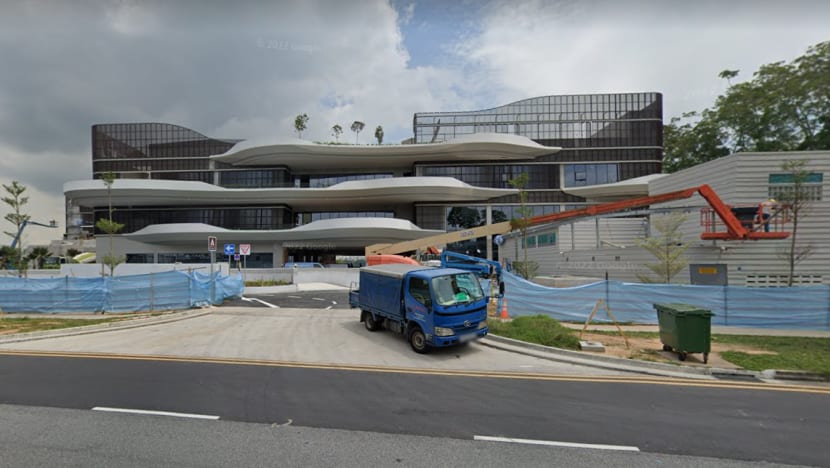Worker who was killed by falling bars used unsafe rigging method at HomeTeamNS clubhouse construction site
Mr Isalm Robiul was crushed by the 2,750kg bundle of rebars, which left him with fatal internal injuries.

Screengrab from Google Street View of HomeTeam NS Bedok.
SINGAPORE: A foreign worker who died after a bundle of rebars fell on him at a construction site for a HomeTeamNS clubhouse had been using an unapproved rigging method, a coroner's court has found.
As a result, a wire used to secure a bundle of rebars weighing 2,750kg that were being lifted by a tower crane snapped.
The bundle fell and struck Mr Isalm Robiul, a 31-year-old Bangladeshi national, leaving him with severe traumatic injuries to his head and body.
Despite other workers frantically extricating him and having him taken to hospital, he died of his extensive injuries.
He leaves behind his wife and three daughters, according to non-profit organisation ItsRainingRaincoats, which focuses on migrant workers in Singapore.
WHAT HAPPENED
Mr Robiul stayed at Sungei Tengah Lodge and was employed as a construction worker by Chin Leong Building Construction.
On the day of the incident on Dec 11, 2021, Mr Robiul was working on a construction site at 900 Bedok North Road.
CMC Construction was erecting a four-storey clubhouse with a swimming pool, car park and 10 chalets for HomeTeam NS at the site.
Mr Robiul was assigned as a rigger and signalman and was at the pool area. As the pool was at the furthest part of the worksite with no vehicular access, heavy and bulky construction materials had to be lifted by a tower crane and deposited there.
The lifting team used an approved rigging method that used a four-legged chain sling to rig the bundles. Each leg of the chain sling could lift 1,500kg, and if all four legs were used, a maximum of 6,000kg could be lifted.
To lift the bundle of rebars involved in the accident, at least two of the chain sling legs had to be looped around the bundle of rebars for the bundle to be lifted safely and securely.
However, Mr Robiul did not follow this method and instead attached the chain sling hooks directly to the bundling wires that held the rebar bundles together.
When the accident bundle was being lifted just above Mr Robiul's head, the tower crane operator felt his machine suddenly shake.
One of the bundling wires of the accident bundle had snapped, and the bundle collapsed on top of Mr Robiul.
Other workers tried to remove the rebars but they were too heavy and could be moved only with equipment.
Mr Robiul was rushed to hospital but pronounced dead that same morning.
An autopsy certified his cause of death as multiple injuries including fractures of his skull, brain injuries and a ruptured spleen.
NOT THE FIRST TIME HE USED UNAPPROVED METHOD
State Coroner Adam Nakhoda said in his findings dated Feb 22 that the lifting supervisor had conducted a pre-lifting briefing before the operations, and that Mr Robiul was adequately trained.
There was a plan in place to ensure that lifting works at the worksite were done safely, with control measures in place.
Howver, despite this, the safety measures were not followed on the day of the accident, and this failure to comply led directly to the accident and death of Mr Robiul.
Mr Robiul had also been observed to use an unsafe rigging method to lift rebars on at least one occasion before the day of the accident.
Riggers and signalmen from another sub-contractor had noticed that Mr Robiul had attached the chain sling hooks directly to the bundling wires that held the rebar bundles together.
The bundling wires were not approved rigging points for lifting of the rebar bundles.
The two riggers who noticed the mistake said they had highlighted it to Mr Robiul, who acknowledged the error. However, neither of the riggers flagged the incident to the supervisor.
The coroner found that when one of the riggers saw Mr Robiul using the incorrect rigging method again on the day of the accident, he should have escalated the matter immediately to his supervisors.
Had the supervisors been informed, it would have been incumbent on them to retrain Mr Robiul in the proper rigging methods, or to reassign him to other tasks. This may have averted the accident, said Judge Nakhoda.
"General workers will often be the first persons to observe unsafe practices at a worksite," he said. "They should have the ability to report unsafe practices with the assurance that any such reports will be treated in confidence."
He concluded that Mr Robiul not only used the unsafe and incorrect rigging method, but also remained near and underneath the partially suspended bundle as he made adjustments to other wires instead of standing away as he should have.
He ruled Mr Robiul's death a work-related misadventure and conveyed his condolences to Mr Robiul's family.














